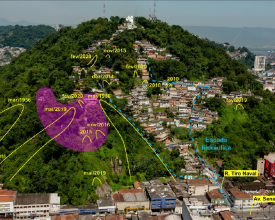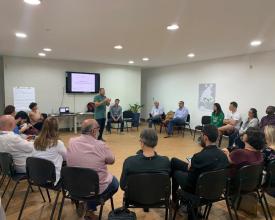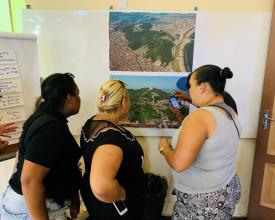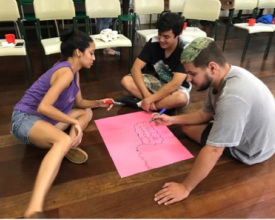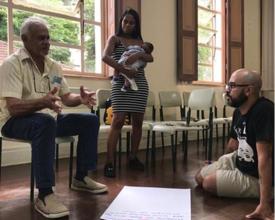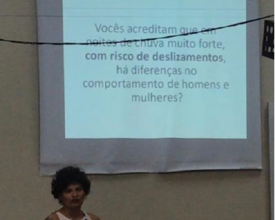
Mesures d'adaptation fondées sur l'écosystème et orientées vers la communauté et le genre : le cas du Monte Serrat, Brésil
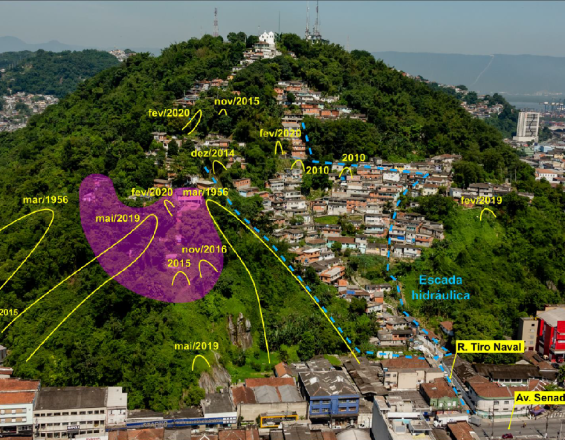
En raison de la densité de population et du coût élevé de la vie, de nombreuses familles ont occupé des zones de collines classées à haut risque en raison de la déforestation et de l'augmentation des précipitations qui entraînent l'érosion des sols et de fréquents glissements de terrain, provoquant la destruction des habitations et même des décès.
Ce scénario a conduit à l'éloignement des familles vers des logements abordables. Les zones inoccupées doivent être réaffectées afin d'éviter toute occupation illégale. La mairie et la communauté, avec le soutien de ProAdapta, ont entamé un processus de discussion participative sur la conception d'une mesure d'adaptation basée sur l'écosystème (EbA) pour le site, en utilisant la restauration des forêts indigènes avec un accent sur l'adaptation au changement climatique et, en même temps, sur le bien-être et la résilience des communautés locales. L'utilisation d'un langage inclusif et non sexiste et la dynamique de groupe avec le personnel de la mairie et les membres de la communauté sur la reconnaissance des privilèges et des différences dans la perception du risque climatique entre les hommes et les femmes ont permis de sensibiliser les participants à l'équité entre les hommes et les femmes.
Contexte
Défis à relever
Les principaux défis étaient les suivants
- Environnementaux : l'accès à la colline, en particulier pendant les saisons des pluies. En outre, la déforestation des collines et, par conséquent, l'érosion et les glissements de terrain, en raison des effets du changement climatique et de la perte de biodiversité.
- Social : intégration entre les secteurs de la mairie ; difficulté à impliquer les résidents de la communauté et à gagner leur confiance ; vulnérabilité sociale et marginalisation des résidents ; enracinement culturel sur place rendant le processus de relocalisation plus long ;
- Économique : limitation des fonds alloués pour la mise en œuvre de la méthodologie EbA ; limitation des ressources et des options pour un meilleur logement pour les résidents.
Emplacement
Traiter
Résumé du processus
L'approche participative (bloc 1) a permis d'intégrer les acteurs de la communauté locale, les techniciens de la mairie, les ONG impliquées dans le Monte Serrat et les consultants de GIZ-ProAdapta. De cette façon, il a été possible de développer des initiatives de sensibilisation à l'égalité des sexes, présentes dans le bloc 2.
L'intégration des acteurs a également permis l'apprentissage d'expériences et l'échange entre les techniciens de la municipalité. Ainsi, il a été possible d'établir une vision intégrée de la planification de l'adaptation au changement climatique dans la ville, ce qui a conduit au bloc 4. Le projet a intégré les points de vue de différents secteurs de la mairie et a permis de relier les politiques publiques entre elles, l'approche EbA étant un thème transversal.
En raison du niveau significatif d'engagement de plusieurs secteurs dans les mesures d'EbA du Monte Serrat atteint dans le processus participatif, décrit dans les blocs 1 et 2, il a été possible de faire des progrès, malgré COVID19, en termes de développement de politiques publiques qui incluent l'EbA et l'approbation par le biais de réunions à distance en utilisant Google Earth et des outils de méthodologie participative (bloc 3).
Blocs de construction
Approche participative - Solutions communautaires
Le sens de la communauté sur le Monte Serrat et les collines environnantes a été fondamental pour le choix d'une approche de participation sociale active. Après tout, ce sont les habitants qui ressentent les effets du changement climatique, tels que les glissements de terrain. Les visites fréquentes de la mairie (défense civile) et les contacts constants avec les habitants ont été extrêmement importants pour gagner la confiance de la communauté, en particulier pour impliquer les jeunes et les résidents les plus récents de la région.
Les familles relogées ont été invitées à participer aux ateliers afin de valoriser leur histoire et les liens tissés dans la région et de profiter des avantages de la mesure EbA.
La stratégie de l'approche participative, conjointe entre les autorités publiques, la société civile et l'assistance de ProAdapta, (i) a renforcé les connaissances de la communauté sur le changement climatique et son lien avec la vulnérabilité climatique locale et (ii) a renforcé les relations de confiance entre les diverses parties prenantes impliquées. Les zones à haut risque qui ont été évacuées doivent être désignées d'urgence et de manière consensuelle avant toute tentative de réoccupation, d'où l'urgence des ateliers EbA.
Les habitants d'autres collines voisines qui souffrent des mêmes problèmes de glissement de terrain ont été invités à participer afin de reproduire la méthodologie et d'étendre la solution.
Facteurs favorables
- Engagement et coopération des techniciens de la ville de plusieurs départements en faveur de la solution EbA
- Affiches sur les ateliers organisés sur le Monte Serrat avec le slogan "Prenons soin de notre colline", éveillant le sentiment d'appartenance et de bien-être.
- Invitation spéciale utilisant un langage inclusif et non sexiste pour s'assurer que les femmes se sentent prises en compte.
- Renforcement de l'organisation représentative des résidents grâce au dialogue encouragé par la municipalité et soutenu par ProAdapta.
- Rétablissement de la commission municipale sur l'urbanisation et la légalisation du Monte Serrat
Leçon apprise
- Initier un dialogue local avec la communauté par l'intermédiaire de "champions" afin d'engager des alliés potentiels et internes avant d'ouvrir et de communiquer l'idée à des personnes externes.
- Observer les alternatives potentielles des mesures d'EbA dans la montagne Monte Serrat tout en communiquant avec la communauté locale.
- Il est utile que la ville travaille simultanément sur des instruments de politique publique relatifs à l'adaptation au changement climatique. Dans le cas de Santos : (a) mise à jour du plan municipal sur le changement climatique et (b) construction du plan municipal sur la récupération et la conservation de la forêt tropicale atlantique avec des objectifs climatiques et EbA avec l'engagement de différents acteurs.
- Documenter une méthodologie consolidée dans des dépliants et des vidéos pour étendre l'EbA à d'autres collines.
- La communication sur les risques climatiques doit être faite de manière consciente et en adoptant un langage accessible. Elle doit également tenir compte de la législation applicable et des besoins d'intervention, en respectant toujours les droits des communautés à l'accès à l'information, à la participation à la prise de décisions concernant les actions qui les affectent directement et au droit à un logement adéquat.
Solution d'EbA basée sur la communauté et différenciée selon les sexes
L'approche du Monte Serrat en matière d'égalité des sexes reconnaît que les femmes sont des victimes, mais qu'elles font aussi partie de la solution. Le changement climatique affecte différemment les groupes socialement, écologiquement et économiquement vulnérables, qu'il s'agisse des femmes, des peuples indigènes ou des communautés. D'autre part, la prise de décision des femmes face aux risques climatiques peut être plus rapide et plus efficace.
Il est essentiel de réfléchir à des solutions qui respectent le droit à la non-discrimination de ces groupes. Guidée par les recommandations internationales, l'intégration de la dimension de genre favorise la participation et l'engagement équitable de toutes les personnes vivant à Monte Serrat. En outre, l'idée était de promouvoir la représentativité du personnel technique chargé de mettre en œuvre les mesures d'EbA.
L'équité entre les sexes a été renforcée à toutes les étapes et a permis une plus grande participation des femmes, y compris des femmes enceintes, des femmes allaitantes et des femmes accompagnées de nouveau-nés et de bébés, sans qu'il soit gênant d'amener des enfants dans l'espace de l'atelier. Elles ont été accueillies et ont bénéficié d'une attention particulière grâce au soutien du secrétariat à l'assistance sociale de la municipalité.
Cela a permis aux femmes de se sentir à l'aise pour contribuer à la construction de solutions EbA qui leur profitent directement, en suggérant une zone de loisirs pour leurs enfants avec des arbres fruitiers qui pourraient être utilisés pour la cuisine.
Facteurs favorables
La dynamique Avante/Personare a permis de sensibiliser le personnel municipal aux questions de genre et de vulnérabilité climatique. Basées sur l'empathie, les activités s'appuient sur des personnages et des cas fictifs pour travailler sur la reconnaissance, en particulier dans une situation d'urgence climatique, des privilèges en termes de classe, de race et de genre avec la communauté et l'équipe technique. Les expériences ont suscité des réflexions et un malaise concernant les relations inégales qui n'existaient pas auparavant parmi les personnes formées.
Leçon apprise
Parmi les suggestions visant à inclure davantage de femmes dans les prochaines étapes du processus participatif figure l'organisation d'ateliers d'éducation socio-environnementale, axés sur l'impact du changement climatique sur les groupes vulnérables. La mise en œuvre doit reposer sur des actions transparentes de la part des agences locales impliquées afin de toujours inclure les femmes et de communiquer avec elles de la même manière qu'avec les hommes.
Il est important de veiller au langage utilisé pour inviter les femmes aux ateliers. Il faut créer un environnement accueillant et confiant pour que les femmes se sentent à l'aise pour parler de leurs perceptions, de leurs idées et de leurs besoins. De nombreuses femmes ont cessé de participer aux ateliers, en particulier le week-end, lorsqu'elles n'avaient personne à qui confier leurs enfants. Une fois le problème identifié, une solution créative a été mise en place pour accueillir les enfants. L'engagement des parties a été fondamental pour renforcer constamment l'application de la perspective de genre dans les solutions environnementales. L'efficacité de la mise en œuvre dépend de l'approche conjointe entre le genre, la vulnérabilité socio-économique, le changement climatique et la restauration de l'environnement.
Approche de la mise en œuvre : Actions virtuelles après planification et engagement - En raison de Covid
Au cours de la période fin 2019 et début 2020, en collaboration avec l'association communautaire, des dialogues ont commencé à planifier la mise en œuvre de la proposition EbA. Les suggestions des résidents, des techniciens de la mairie et de l'équipe de la GIZ ont été observées. Cependant, en février et mars 2020, il y a eu des pluies torrentielles (événements extrêmes) qui ont provoqué des glissements de terrain sur le Monte Serrat et d'autres collines de la municipalité, causant la mort de certains d'entre eux et la destruction de maisons, ce qui a rendu impossible la poursuite des travaux.
Alors que la communauté se remettait et se restructurait, la pandémie de COVID a commencé et, avec elle, l'annulation de toutes les activités des acteurs impliqués. Pendant cette période, la communauté est également restée unie, cherchant à minimiser les dommages causés par les pertes d'emploi et les maladies causées par la pandémie.
Pendant la brève période entre la fin des pluies et le début de la pandémie, les techniciens de la ville ont commencé à récupérer les pentes de certaines collines en plantant des espèces indigènes selon la méthodologie EbA apprise. Cependant, la pandémie a empêché la poursuite de tous les travaux sur le Monte Serrat et sur les autres collines.
Après s'être adapté au nouveau scénario de la pandémie, des réunions virtuelles ont été organisées en 2020 et 2021 afin de suivre la situation de la communauté, de reprendre les activités et de planifier le projet de communication.
Facteurs favorables
- Renforcement de la représentativité des habitants par le dialogue promu par la mairie et soutenu par ProAdapta ;
- Avant la pandémie de COVID, formation en face à face avec les techniciens de la mairie par l'équipe de ProAdapta ;
- L'importance de l'interaction virtuelle et en face à face avec les leaders communautaires (Association des résidents) pour maintenir le contact avec la communauté.
Leçon apprise
- Le renforcement de l'association des résidents est fondamental pour l'agilité et l'efficacité de la communauté dans sa réponse aux événements extrêmes et à la pandémie ;
- Le maintien du contact avec la communauté par l'intermédiaire de l'association des résidents a permis de savoir et de comprendre ce que la communauté vivait et comment interagir avec elle ;
- Le respect et la confiance mutuelle acquis pendant la construction de la proposition EbA, avant les événements extrêmes et la pandémie de COVID, ont permis de reprendre et d'adapter le projet sous forme d'actions de communication pour la communauté et pour les autres collines de la municipalité ;
- La formation des techniciens de la mairie a permis d'intégrer les principes de l'EbA dans les actions sur les autres collines après les événements extrêmes ;
- Le recadrage des espaces collectifs au sein de la communauté, en mettant l'accent sur l'utilisation pour la mise en œuvre des mesures d'EbA ;
- L'absence de pépinières pour les semis d'espèces indigènes et d'un modèle préétabli pour la restauration des zones forestières indigènes et des services environnementaux rend difficile l'acquisition d'espèces adéquates pour la mise en œuvre de la proposition EbA.
LIEN AVEC LES POLITIQUES PUBLIQUES : Plan d'action climatique de Santos (PACS), Plan de conservation et de restauration de la forêt atlantique (PMMA) et Action climatique et course à la résilience de l'État de Sao Paulo.
La mesure EbA a été discutée et incluse en tant que mesure de mise en œuvre pratique lors de l'élaboration des politiques publiques suivantes dans la région : (a) PACS - Plan d'action climatique de Santos
(b) Plan municipal de récupération et de conservation de la forêt atlantique (PMMA) (c) Étude sur la gouvernance de l'adaptation au niveau infranational et (d) Plan d'adaptation de l'État de São Paulo dans le cadre de la course à la résilience.
Ces plans et guides ont été élaborés avec la participation d'un grand nombre d'acteurs divers, ont été approuvés et seront lancés en janvier 2022.
Pendant la phase de lancement de la mesure EbA au Monte Serrat, l'élaboration du PMMA et du PACS a commencé à être discutée en 2019 et a finalement été approuvée en 2021. Depuis le début, le PMMA a appliqué le cycle de l'EbA, l'équité entre les sexes et l'optique du changement climatique.
La méthodologie EbA a été caractérisée comme un objectif commun des secteurs multiples qui a encouragé une volonté politique diversifiée et a permis l'intégration entre les politiques environnementales, urbaines et de réduction des risques dans la municipalité de Santos. L'institutionnalisation des politiques publiques permet le renforcement de l'EbA, sa reproduction et l'implication du secteur privé.
Facteurs favorables
- La coordination des actions, des discussions politiques par le CMMC a permis d'unifier les mesures, les événements et les politiques publiques en cours de construction.
- Les pluies torrentielles de 2020 ont contribué à un examen attentif et approfondi de l'analyse des risques climatiques de la municipalité et du chapitre EbA du PMMA, et ont permis l'intégration des connaissances en matière d'EbA dans d'autres sections et projets, y compris dans le secteur privé.
- Une gouvernance solide a permis l'affectation de personnel compétent issu de plusieurs secteurs, l'implication et l'engagement d'autres secrétariats et conseils municipaux en faveur de l'objectif commun de l'EbA.
Leçon apprise
- Les mesures d'EbA ont contribué à renforcer la volonté politique des responsables municipaux et de la population d'élaborer et d'approuver les politiques publiques connexes telles que le PMMA et le PACS.
- L'existence d'une base de données municipale a joué un rôle important ;
- La nécessité de mener des recherches/études dans la zone de la municipalité par des institutions locales d'éducation/de recherche pour créer/alimenter la base de données ;
- La participation des différents secrétariats municipaux est essentielle pour le développement des politiques publiques proposées par le PMMA et le PACS ;
- Le fonctionnement des conseils municipaux avec la participation d'institutions et de représentations de différents secteurs (privé, à but non lucratif et public) a fourni un soutien technique et politique important dans le développement de projets et de politiques ;
- Le soutien et l'interaction avec d'autres conseils municipaux ont renforcé les discussions et l'analyse critique.
- Les partenariats institutionnels et le soutien de la GIZ avec des équipes de consultants en renforcement des capacités sur les méthodologies EbA et la conception de stratégies ont joué un rôle important dans les résultats obtenus.
Impacts
Le cas de l'EbA à Monte Serrat, Santos, a les impacts positifs suivants :
- Il a permis le travail conjoint entre différents secteurs de la mairie (secrétariat des travaux, développement urbain, environnement, sécurité publique, assistance sociale, santé, administration des collines) ainsi que des institutions de la société civile (association des améliorations de Monte Serrat, ONG Guerriers de la paix), en promouvant le dialogue pour un bien commun et en renforçant la confiance entre les secrétariats de la mairie, les départements et la société civile ;
- Il a encouragé la formation des techniciens et de la communauté à la méthodologie EbA, qui intègre la relation entre les services humains, les services écosystémiques et la résilience climatique ;
- Il a permis une réflexion sur l'égalité des sexes et les impacts inégaux du changement climatique ;
- Il a favorisé les revenus de la communauté, car les ateliers ont été mis en place avec le soutien et le travail des femmes de Monte Serrat ;
- Il a favorisé la réflexion sur l'importance de la biodiversité et des services écosystémiques ;
- Il a ouvert un horizon de possibilités et d'opportunités pour la communauté et a donné un nouveau sens à l'environnement naturel en tant que source possible de revenus et de sécurité alimentaire.
Bénéficiaires
Sur le Monte Serrat vivent 654 hommes et 721 femmes qui bénéficient du travail du projet. 40 techniciens de la mairie de Santos ont été formés. La reproduction de la méthodologie pour la mise à l'échelle est en cours au niveau régional avec 8 autres villes.
Objectifs de développement durable
Histoire
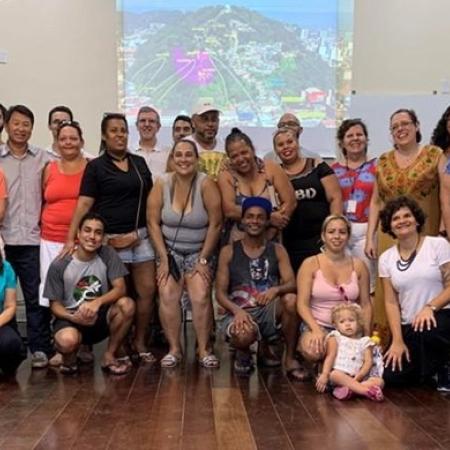
"Moi, Arquimedes, j'ai pris l'engagement personnel de me battre pour que le Monte Serrat devienne le meilleur endroit et pour que la colline où je vis reçoive ce qu'il y a de mieux, mais nous sommes toujours confrontés au découragement (de nombreux habitants) en raison de longues années de négligence et d'atermoiements. Il est encore difficile de sortir de cette culture (urbaine), étant né ici, mais je me suis permis de faire de nouvelles expériences et d'ouvrir les portes du Monte Serrat à tout le monde et d'apprendre à connaître la méthodologie de l'adaptation basée sur l'écosystème (EbA).
Aujourd'hui, nous pouvons voir les possibilités qui s'offrent à nous, en faisant partie d'un projet unique visant à transformer l'environnement dans lequel nous vivons. Réduire l'impact que nous avons nous-mêmes sur le Monte Serrat, c'est comme demander pardon à cette montagne.
Notre mission est grande, notre responsabilité est énorme et je vois combien il est important pour nos habitants de voir comment les techniciens de ce projet le voient. Mon imagination dessine et reproduit un monde parfait, parce que je ne peux pas me permettre de voir autre chose que cela, parce que c'est ce que nous vivons aujourd'hui.
L'estime de soi des résidents doit être conquise et je ferai tout ce qui est en mon pouvoir pour qu'il y ait une participation des résidents. Le sentiment d'appartenance existe, mais il est ébranlé par la possibilité de partir d'ici et par d'autres qui ne croient toujours pas à la politique d'achat de votes".
Arquimedes Machado, président de l'association d'amélioration du Monte Serrat, 13 mars 2020
